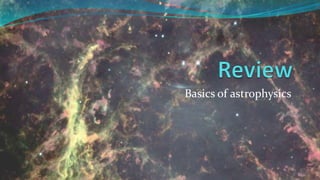Basics Of Astrophysics
- 2. Stars Story Hydrostatic equilibrium Mass Luminosity - Temperature
- 4. Proton – Proton Chain As happens in the core of a typical main sequence star. 0.23% 99.77% 10-5% 15.08% 99.9% 0.1% 84.92%
- 5. Neutrino Leptons No electrical charge Passes through ordinary matter
- 6. Problem Determine the maximum size of rotating body with rotation period = 0.033 second
- 9. Neutron Stars The core of a massive star in a supernova Chandrasekhar limit (12.5) Stable state Most SNs produce NSs -> 108 – 109 NSs in universe The T of a NS falls from 1012K to 1011 K in 2 seconds A young NS is about 106 K
- 11. 1987A’s Timeline Feb.23 7:35am, a total number of 24 neutrons detected Hours later the visible SN discovered Neutrinos and antineutrinos reached the earth synchronously : matter, antimatter and photos react the same against gravity 1987A was a blue supergiant! Missing neutron star
- 12. 1987A 1987 was discovered in Feb., but reached the brightest in Mar. AAVSO observations
- 14. Rings turning on Months after SN Emission lines UV The distance: 168,000 ly
- 15. Neutrinos in Supernovas Direct observation of SNs is impossible Dense gas surrounds SNs, and… Information about the inner most regions of a SN No interaction with matter Delay of 1987 visible light First impressions in 1987
- 16. Some Facts Much of the visible light comes from the decay of radioactive elements produced by the supernova shock wave, and even light from the explosion itself is scattered by dense and turbulent gases. The neutrino burst is expected to reach Earth before any electromagnetic waves (SNEWS)
- 17. So Was the total energy released in a SN less than the energy that ionized shell emits? 99% of energy (1046 j) -> neutrinos Where all these neutrinos come from?
- 18. Urca process (Z-1,A) -> (Z,A) + e- + ν-e (Z,A) + e- -> (Z-1,A) + νe Two forms of beta decay Baryons - Leptons Gamow, Loosing energy (cooling), Casino Urca
- 19. Beta decay Beta Minus Beta Plus Electron Capture
- 20. Pulsars Discovery 1967 as little green men Neutron stars are low in luminosity (why?)
- 21. Giant atomic nucleus Fluid Super conductor Magnetic dipole radiation Spin periods of pulsars increase by time
- 24. Widescreen Test Pattern (16:9) Aspect Ratio Test (Should appear circular) 4x3 16x9

